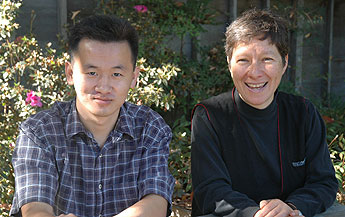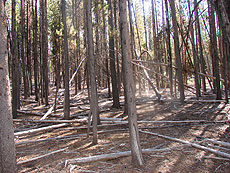
Lue Vang, left, assisted anthropology professor Anna Tsing on her research into the global commodity chain of matsutake mushrooms. Photo: Jennifer McNulty |
January 1, 2007
Bilingual undergrad plays key role in anthropology professor’s fieldwork
By
Jennifer McNulty
Almost as difficult as hunting for the proverbial needle in a haystack, foraging for prized wild matsutake mushrooms requires a keen eye, an experienced hand, and a good sense of direction.

Matsutake mushrooms, above, grow at elevations of about 5,000 feet in Oregon in dense forests of mixed conifers, lodgepole pines, and ponderosa pines.
Photos: Lue Vang |
 |
One of Japan’s most culturally significant foods, matsutakes grow underground in densely forested areas, where the only sign of their presence is a slight disturbance of the soil above the mushroom cap.
The best foragers spy the telltale soil mounds, confirm their find with a touch, and remove the fungus in a sequence of quick and artful moves, says anthropology professor Anna Tsing, who is studying the global commodity chain of matsutakes.
"Foraging in the forest is the world's oldest economy," said Tsing, a cultural anthropologist whose research explores how cultural diversity may actually facilitate global economic and scientific connections. "Matsutake mushrooms are highly valued in Japan as prestigious gifts that convey refined, gourmet sensibilities. They are valued particularly for their smell, which is sweet and spicy, a bit like cinnamon."
During Japan's "economic bubble," matsutakes were prized as corporate perks and expensive gifts. "A handful of mushrooms from Kyoto may have cost $3,000," she explained.
As demand grew and Japanese matsutakes became scarce, new markets emerged in southwest China, North and South Korea, Morocco, Turkey, British Columbia, and the Pacific Northwest, particularly central Oregon, said Tsing. Coincidentally, the emergence of Oregon's matsutake market corresponded with a huge influx to California of immigrants from Southeast Asia.
"Word spread like wildfire, and Southeast Asians started flocking to the Pacific Northwest," said Tsing, who first learned of Oregon's matsutake market from Santa Cruz mushroom afficionado David Arora.
Tsing immediately saw the opportunity to explore her interests in global commodities, multiculturalism, and how people interact with the landscape. This fall, she made her third trek to the Cascade Mountains to observe the matsutake harvest.
This year, Tsing brought in a research collaborator: Undergraduate Lue Vang got a crash course in ethnographic research and made significant contributions to the project.
Vang, who is of Hmong descent, speaks Hmong and built sufficient trust with some pickers that he was able to conduct lengthy interviews. Two men even allowed Vang to accompany them foraging, a rare opportunity as pickers don't reveal their foraging sites to others.
"There are at least five languages being spoken at the camps that I don't know," said Tsing, who speaks Indonesian, Meratus, and some Chinese. "Lue was an enormous help with Hmong pickers."
Coincidentally, Vang, an anthropology major, began collecting mushrooms as a hobby after becoming a UCSC student. Last spring, he took Tsing's spring seminar on life histories and compiled his elderly father's life story as a class project. His Hmong Laotian father, who is in his 80s, worked with the CIA during the Vietnam War and spent five years in a refugee camp in Thailand before eventually settling in Fresno, where Vang was raised.
Tsing and Vang first collaborated on that project, spending three days interviewing Vang's father. "It was a tremendous opportunity for me to learn something about the Hmong community in Fresno," said Tsing. "Lue was a full collaborator. I've never done that with an undergraduate before."
Impressed by Vang's work, Tsing invited him to collaborate with her in Oregon.
"Ethnography is kind of an art," said Tsing. "You have to develop an ear for it, rather than approach it as a mechanical data-gathering exercise."
Instead of structured interviews, ethnographic researchers engage in lengthy conversations to "glean insights," said Tsing, who described the community of Southeast Asian mushroom pickers as close-knit and private.
"We tried to pick, but they were often quite private, and they don't give up their places," she said. "Fieldwork can be really frustrating. It's not as simple as people think."
Vang recalled what other anthropology professors told him before he embarked on the five-week journey. "They said it's like vacation and work at the same time, because you have to relax at the same time that you're working," said Vang. "I thought I'd chit chat with Hmong about mushrooms and their lives. But once I got there, they refused, saying they had no time. They worked from six in the morning until four in the afternoon, and afterwards they were too tired to talk."
Ultimately, Vang succeeded by "just being myself," he said. "With Hmong people, I'm very talkative. I'd wait behind the motels every day until some finally made time for me."
On a picking outing with Hmong pickers, Vang was struck by how well they navigated the dense forest without any roads, signs, or distinguishing landmarks. "They find the highest point to get an overview of the landscape and then use the sun for direction," said Vang.
Southeast Asian refugees are among the best foragers, in part because they draw on the navigational skills they developed in Laos and Cambodia, said Tsing.
"Hmong and Mien have very good forest navigational skills," said Tsing, laughing as she recalled how quickly she and Vang became lost one day. It turned out they were within only about 200 yards of the base camp where they started.
In Oregon, matsutakes grow at about 5,000 feet elevation in dense forests of mixed conifers, lodgepole pines, and ponderosa pines. In the 1990s, the U.S. Forest Service established a camp for mushroom pickers that remains in use today. Part of Tsing's work explores "how people understand the landscape" and their "special ways of making familiar places."
Through conversation with pickers, Vang learned about a cultural practice of great significance among the Hmong. When someone dies a "bad death," the person is believed to leave a malignant spirit that haunts the place of death, which Hmong will then avoid. One man described becoming very scared and feeling almost paralyzed in an area where he later learned someone had died, said Vang.
"It was only through Lue's interviews that I realized these areas are really important," said Tsing.
"Mushrooms are full of mystery," said Tsing. "Matsutakes grow in very sandy or volcanic soil and appear seemingly out of nowhere. They have a symbiotic relationship with trees, deriving all their sugars from the tree while channeling soil nutrients into the tree."
This year, pickers in Oregon were paid $8 to $50 per pound for the highest-quality matsutakes, she said. After foraging, they sell their mushrooms to buyers at roadside stands. By 11 p.m., those buyers have transferred the goods again to field agents, and the mushrooms are trucked to warehouses in Portland, Seattle, and Vancouver, British Columbia, for cleaning, grading, and shipping to Japan the next morning by exporters.
"It all happens very fast because it's a fresh market," she added. "The oldest economy in the world has joined the newest technologies of globalization to transfer fresh produce across the Pacific in a matter of hours."
As cultural diversity is woven into today's global entrepreneurship, Tsing sees an opportunity for students and faculty to work together. "Students at UCSC bring a variety of cultural backgrounds to their educations," she said. "Anthropologists need their help in deciphering the new landscape of cultural complexity and global integration."